7 Product Photography Examples to Inspire You in 2025
 ProdShot Creator
ProdShot Creator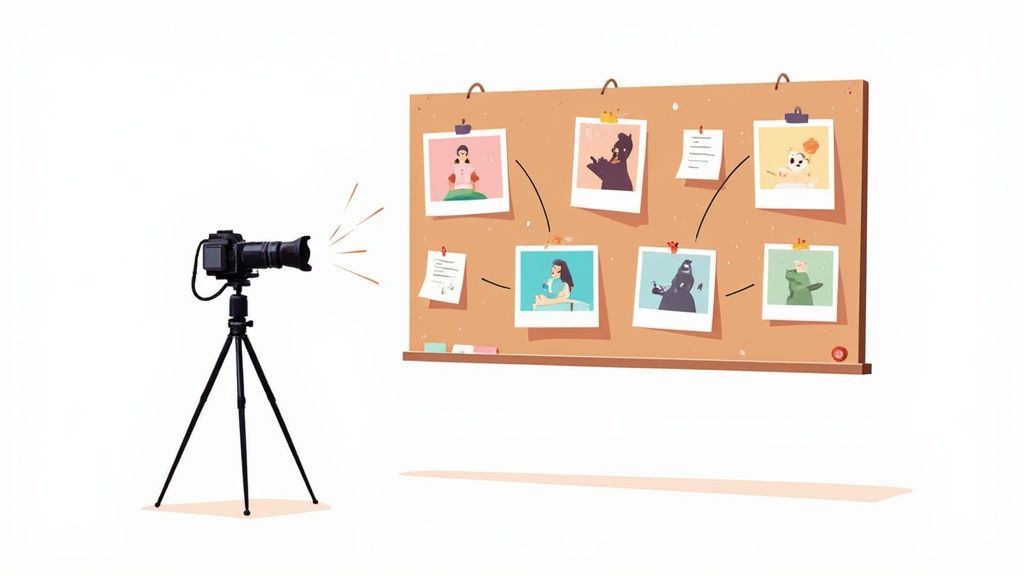
In e-commerce, a picture isn't just worth a thousand words; it's worth the sale. High-quality product photography is the single most effective tool for converting browsers into buyers, building brand trust, and communicating value before a customer ever holds your item. Yet, knowing where to start can be daunting. What separates a good photo from a great one? How do you create images that stop the scroll and drive action?
This guide moves beyond generic advice to provide a curated gallery of powerful product photography examples. We will deconstruct exactly what makes each image work, breaking down the specific techniques, lighting setups, and strategic thinking behind them. You won't just see beautiful pictures; you'll get a blueprint with actionable takeaways to replicate these results for your own brand.
We will analyze seven distinct styles, from clean white background shots essential for marketplaces to compelling lifestyle scenes that tell a story. Each example includes a strategic breakdown, highlighting the methods used and the customer psychology at play. To further explore visual content opportunities beyond static images, you might also consider professional media and photography services that offer a wider range of solutions. Let's dive into the examples that will elevate your product presentation.
1. White Background Product Photography
White background product photography is the undisputed champion of e-commerce. This classic style isolates a product against a pure white backdrop, eliminating all distractions and focusing the customer's full attention on the item itself. It's the standard for major marketplaces like Amazon and is essential for creating a clean, professional, and consistent look across a digital storefront or catalog.
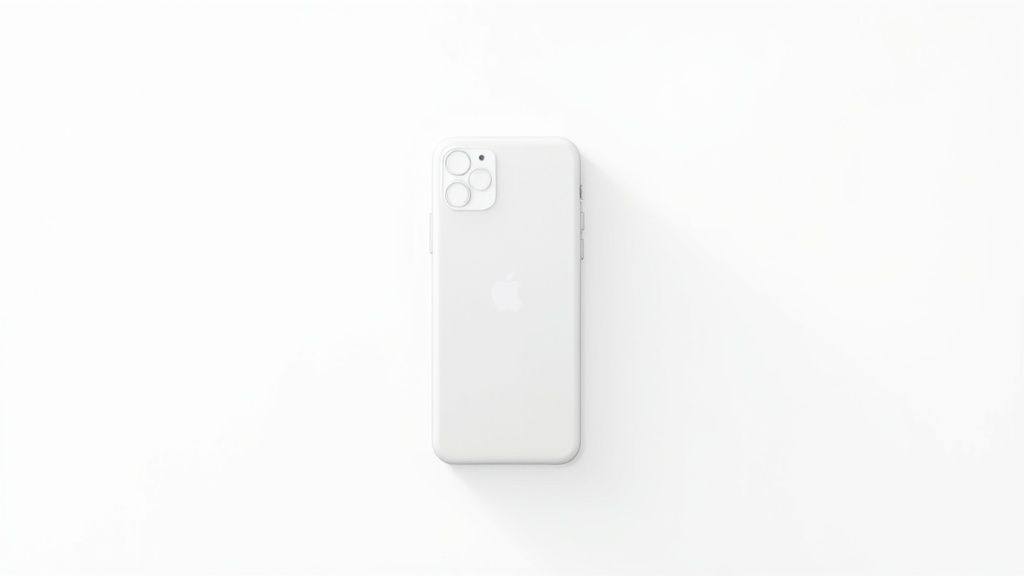
This approach, popularized by giants like Apple and Amazon, uses even, diffused lighting to minimize harsh shadows and accurately represent a product’s shape, texture, and color. The goal is clarity and consistency, which builds consumer trust and simplifies the buying process.
Strategic Breakdown
The power of this technique lies in its simplicity and universal application. By removing environmental context, you create a versatile image that can be used across various platforms without clashing with different website designs or branding. This is one of the most fundamental product photography examples because it prioritizes product detail over artistic flair, directly serving the needs of an online shopper.
Key Insight: A pure white background isn't just a stylistic choice; it's a strategic tool for conversion. It reduces cognitive load for the shopper, making it easier for them to evaluate the product and make a purchase decision quickly.
How to Replicate This Style
Creating professional-looking white background photos is achievable even for beginners.
- Lighting is Paramount: Use a large, diffused light source like a softbox or an umbrella. Place it at a 45-degree angle to the product to create soft, even lighting.
- Fill the Shadows: Position a white foam board or a reflector on the opposite side of your main light. This will bounce light back onto the product, softening any remaining shadows.
- Camera and Lens: A camera with manual controls is ideal. Use a 50mm or a macro lens to avoid distortion and capture sharp details.
- Post-Processing: Shoot in RAW format for maximum editing flexibility. In software like Adobe Lightroom or Photoshop, adjust the exposure, fine-tune the white balance, and use tools to "cut out" the background to achieve a perfect, pure white (#FFFFFF). This final step is crucial for meeting marketplace requirements.
2. Lifestyle Product Photography
Lifestyle product photography moves beyond the studio to show a product in its natural habitat. This contextual style places items in real-world settings or depicts them being used by people, helping customers visualize how the product will fit into their own lives. It's less about sterile features and more about storytelling, aspiration, and creating an emotional connection with the consumer.
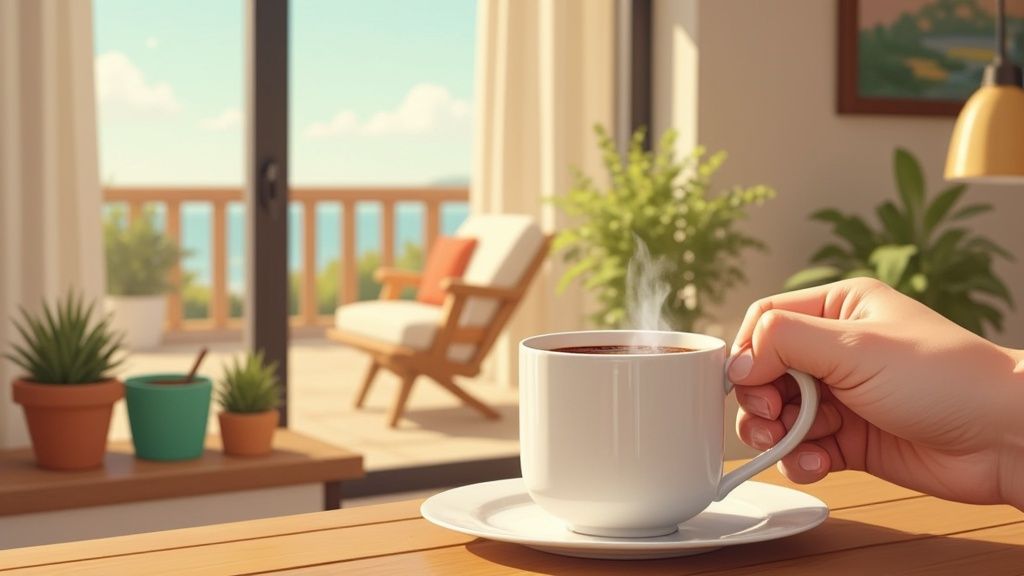
This approach has been masterfully used by brands like Patagonia and Nike, which showcase their gear in authentic, action-packed environments. The goal is to sell not just a product, but the experience and identity associated with it. By demonstrating the product's value in a relatable scenario, brands build a powerful narrative that resonates deeply with their target audience.
Strategic Breakdown
The effectiveness of lifestyle photography comes from its ability to answer the customer's unspoken question: "How will this improve my life?" By creating a scene that reflects the customer’s aspirations, you're selling a feeling or an outcome. This is one of the most powerful product photography examples for building brand affinity and justifying a premium price, as it connects the item to a desirable way of life.
Key Insight: Lifestyle photography transforms a product from a simple object into a key part of a story. This narrative-driven approach is highly effective on social media and content marketing platforms where engagement is driven by authenticity and emotion, not just specifications.
How to Replicate This Style
Creating compelling lifestyle imagery requires careful planning and a focus on authenticity.
- Define Your Story: Before shooting, create a mood board and a detailed shot list. Understand your target audience's lifestyle and build a scene that authentically reflects it.
- Embrace Natural Light: Whenever possible, use natural light to create a soft, believable, and inviting atmosphere. Shooting during the "golden hour" (just after sunrise or before sunset) provides warm, flattering light.
- Focus on Action and Emotion: Direct models to interact with the product naturally rather than posing stiffly. Capture candid moments and genuine expressions to make the scene feel real and relatable.
- Styling is Key: The environment, props, and model's wardrobe should all support the brand's aesthetic and the story you're telling. Every element in the frame should feel intentional and cohesive.
3. Flat Lay Product Photography
Flat lay photography, also known as overhead or top-down photography, is a visually compelling technique where items are arranged on a flat surface and shot from a bird's-eye view. This style excels at storytelling, allowing brands to display a collection of products, ingredients, or accessories in one cohesive and aesthetically pleasing composition. It has become a dominant force on social media platforms like Instagram and Pinterest for its clean, organized, and creative appeal.
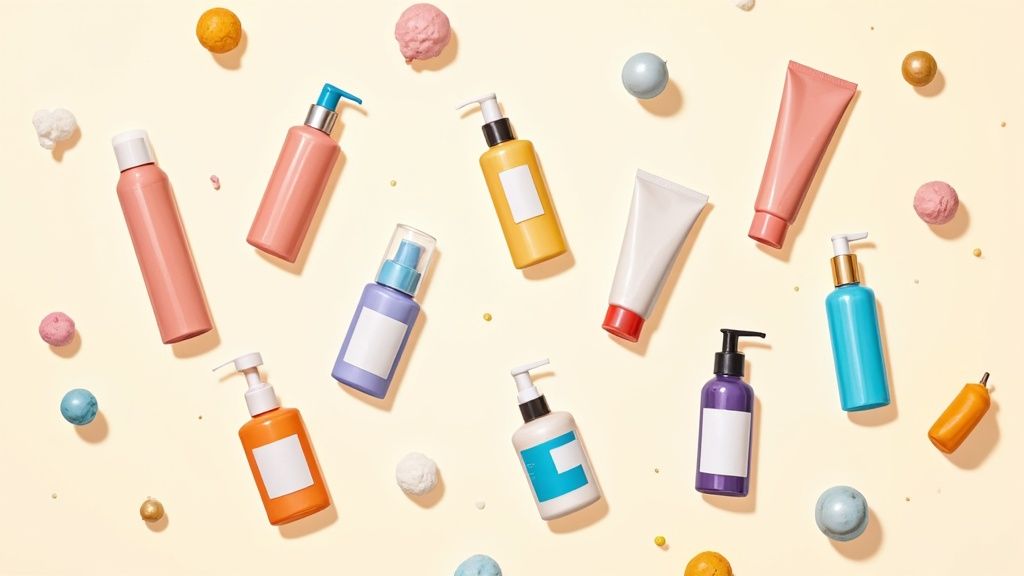
Popularized by fashion and beauty influencers, this method transforms simple products into a curated narrative. It's incredibly effective for showing how different items can be used together, such as a complete outfit, the contents of a makeup bag, or the ingredients for a recipe. The result is an image that feels both aspirational and informative.
Strategic Breakdown
The power of the flat lay lies in its ability to create context and showcase a lifestyle. Unlike isolated product shots, flat lays suggest use-cases and pairings, inspiring customers and encouraging them to purchase multiple items. This makes it one of the most powerful product photography examples for building a brand's aesthetic and driving engagement, especially on visually-driven platforms. These images are highly shareable and can communicate a brand's entire vibe in a single shot.
Key Insight: A well-executed flat lay does more than just show products; it sells a story. By carefully arranging complementary items, you can create a scene that resonates with your target audience's lifestyle and aspirations, making the products feel more relevant and desirable.
How to Replicate This Style
Mastering the flat lay is about composition, lighting, and a steady hand.
- Stable Overhead Setup: A tripod with an overhead arm or a C-stand is essential to get a perfectly parallel, stable shot from directly above. This prevents distortion and blurry images.
- Background and Composition: Choose a background (wood, marble, colored paper) that complements your products. Arrange items with intentional spacing, using principles like the rule of thirds to create a balanced yet dynamic composition. Layering objects can add depth.
- Even Lighting: Use large, soft light sources on either side of your setup to eliminate harsh shadows cast by the products or your camera. Natural light from a large window also works well.
- Styling Props: Incorporate props that fit your brand's story, like flowers, coffee cups, or magazines. These elements should enhance the main product, not distract from it. Ensuring every element is sharp and clear is crucial, and you can learn more about perfecting your shots with a reliable shipment photo editor.
4. Ghost Mannequin Photography
Ghost mannequin photography is a sophisticated technique used primarily for apparel that gives clothing a hollow, three-dimensional form. This effect is achieved by photographing a garment on a mannequin or model and then digitally removing the person or form in post-production. The result is a lifelike image that shows the garment's fit, shape, and drape without the distraction of a model.
This method, a staple for fashion e-commerce giants like Zara and H&M, bridges the gap between a flat-lay photo and a live model shoot. It provides valuable context on how the clothing hangs on a human body, helping customers visualize the fit more accurately while maintaining a clean, uniform catalog aesthetic.
Strategic Breakdown
The power of the ghost mannequin effect lies in its ability to combine the benefits of model photography with the consistency of a white background shot. It answers the customer's crucial question, "How will this look on me?" without introducing the potential bias or distraction of a human model. This technique is one of the most effective product photography examples for fashion because it focuses entirely on the product’s form and structure. For a deeper look into this specialized area, you can learn more about fashion product photography on prodshot.net.
Key Insight: Ghost mannequin photography elevates product presentation by creating a "hollow man" illusion. This allows the customer to mentally project themselves into the clothing, improving their connection with the product and increasing their confidence to purchase.
How to Replicate This Style
Creating a convincing ghost mannequin effect requires a meticulous, multi-shot process.
- Use a Removable Mannequin: Invest in a ghost mannequin with removable chest and neck pieces. This is crucial for capturing the interior parts of the garment, like the collar and brand tag.
- Shoot Multiple Angles: First, photograph the garment on the full mannequin. Then, remove the mannequin and turn the garment inside-out to photograph the neck and any other interior details that would be visible.
- Consistent Lighting: Use even, diffused lighting from both sides (e.g., two softboxes at 45-degree angles) to eliminate shadows and ensure the garment's texture and color are accurately represented.
- Composite in Post-Production: In a program like Adobe Photoshop, layer the images. Place the interior shot behind the main exterior shot, carefully masking out the mannequin pieces to create a seamless, 3D illusion.
5. Macro Product Photography
Macro product photography is an extreme close-up technique designed to reveal the hidden world within a product. It captures intricate details at magnifications often greater than a 1:1 ratio, showcasing textures, craftsmanship, and features that are invisible to the naked eye. This style is paramount for luxury goods, jewelry, and technical products where fine detail signifies quality and value.
Popularized by luxury watchmakers like Rolex and high-end jewelry brands, this approach transforms minuscule elements into heroic features. It communicates superior craftsmanship and material quality, justifying a premium price point by making the abstract concept of "quality" tangible and visible for the customer.
Strategic Breakdown
The strategic power of macro photography lies in its ability to build desire and trust through transparency. By inviting customers to scrutinize every detail, from the delicate weave of a fabric to the precise setting of a gemstone, you are demonstrating confidence in your product's quality. These kinds of product photography examples are effective because they go beyond showing what a product is; they show how it is made, which is a powerful narrative tool.
Key Insight: Macro shots serve as a proof of quality. They allow you to highlight specific, high-value features that differentiate your product from competitors, turning a simple product image into a compelling story about craftsmanship and precision.
How to Replicate This Style
Mastering macro photography requires patience and specialized equipment, but the results are unparalleled.
- Invest in a True Macro Lens: A dedicated macro lens (e.g., 100mm or 105mm) is essential for achieving the necessary 1:1 magnification and edge-to-edge sharpness.
- Stability is Non-Negotiable: Use a sturdy tripod and a remote shutter release or camera timer to eliminate all vibrations. The slightest movement is amplified at this magnification and will ruin the shot.
- Master Focus Stacking: Due to the extremely shallow depth of field in macro shots, use a technique called focus stacking. Take multiple photos at different focus points and merge them in post-processing software (like Adobe Photoshop or Helicon Focus) to create one image that is perfectly sharp from front to back.
- Control Your Lighting: Use small, diffused light sources. LED panels, ring lights, or small softboxes allow for precise control to sculpt the tiny details and textures without creating harsh, distracting glares.
6. 360-Degree Product Photography
360-degree product photography elevates the online shopping experience by giving customers control. This interactive technique involves capturing a series of images as a product rotates on a turntable, which are then stitched together to create a seamless, rotatable animation. It allows shoppers to examine an item from every angle, closely mimicking the in-store experience of picking up and inspecting a product.
This immersive method is particularly powerful for complex products like consumer electronics, furniture, or fashion accessories where details on all sides matter. By providing a complete view, it answers customer questions visually, builds confidence, and has been proven to increase conversion rates while simultaneously reducing returns.
Strategic Breakdown
The core strategy behind 360-degree photography is to bridge the gap between digital browsing and physical interaction. It directly addresses a primary limitation of e-commerce: the inability to touch and feel a product. This is one of the most effective product photography examples for demonstrating form, features, and build quality in a way that static images cannot, empowering the customer with more information and a greater sense of certainty.
Key Insight: 360-degree views are not just a feature; they are a trust-building mechanism. By showing every angle, you signal transparency and have nothing to hide, which significantly reduces purchase anxiety for high-consideration items.
How to Replicate This Style
Creating a smooth 360-degree spin requires precision and the right equipment.
- Use a Turntable: An automated, motorized turntable is essential for a consistent rotation speed and evenly spaced shots. This ensures the final animation is fluid, not jerky.
- Consistent Lighting: Your lighting setup must remain completely static throughout the entire rotation. Any change in light or shadow will cause a noticeable flicker in the final animation.
- Capture Enough Frames: Plan to shoot between 24 and 72 individual photos for a full 360-degree rotation. More frames will result in a smoother spin, but also a larger file size.
- Specialized Software: Use dedicated 360-degree product photography software to automate the capture process and stitch the images together into an interactive file (e.g., HTML5, GIF).
- Post-Processing Consistency: Editing is crucial for a professional look. For expert help, you might explore product photo editing services to ensure every frame is perfectly consistent in color and exposure.
7. Creative Conceptual Product Photography
Creative conceptual product photography elevates an item beyond its physical form, turning it into the hero of a story. This artistic approach uses symbolism, surreal elements, and imaginative settings to communicate brand values, product benefits, or an emotional message. Instead of just showing what a product is, it shows what a product represents. This style is powerful for building a strong brand identity and creating memorable, shareable images.
This method is favored by brands like Nike and Coca-Cola, who sell not just products but also ideals and feelings like achievement and happiness. By embedding the product in a larger narrative, they forge a deeper connection with their audience, making the item part of an aspirational lifestyle or a powerful idea.
Strategic Breakdown
The goal here is not just to sell a product but to sell a concept. This technique is one of the most compelling product photography examples for brands looking to stand out in a saturated market. To truly make your product photos resonate and engage your audience, understanding effective visual storytelling techniques can be invaluable, especially when aiming for creative conceptual shots. The resulting images are highly effective in advertising campaigns and on social media, where unique and thought-provoking content drives engagement.
Key Insight: Conceptual photography transforms a product from a commodity into an experience. By associating your product with an abstract idea like freedom, luxury, or innovation, you create powerful brand equity that transcends features and price points.
The following concept map illustrates the core components of this approach.
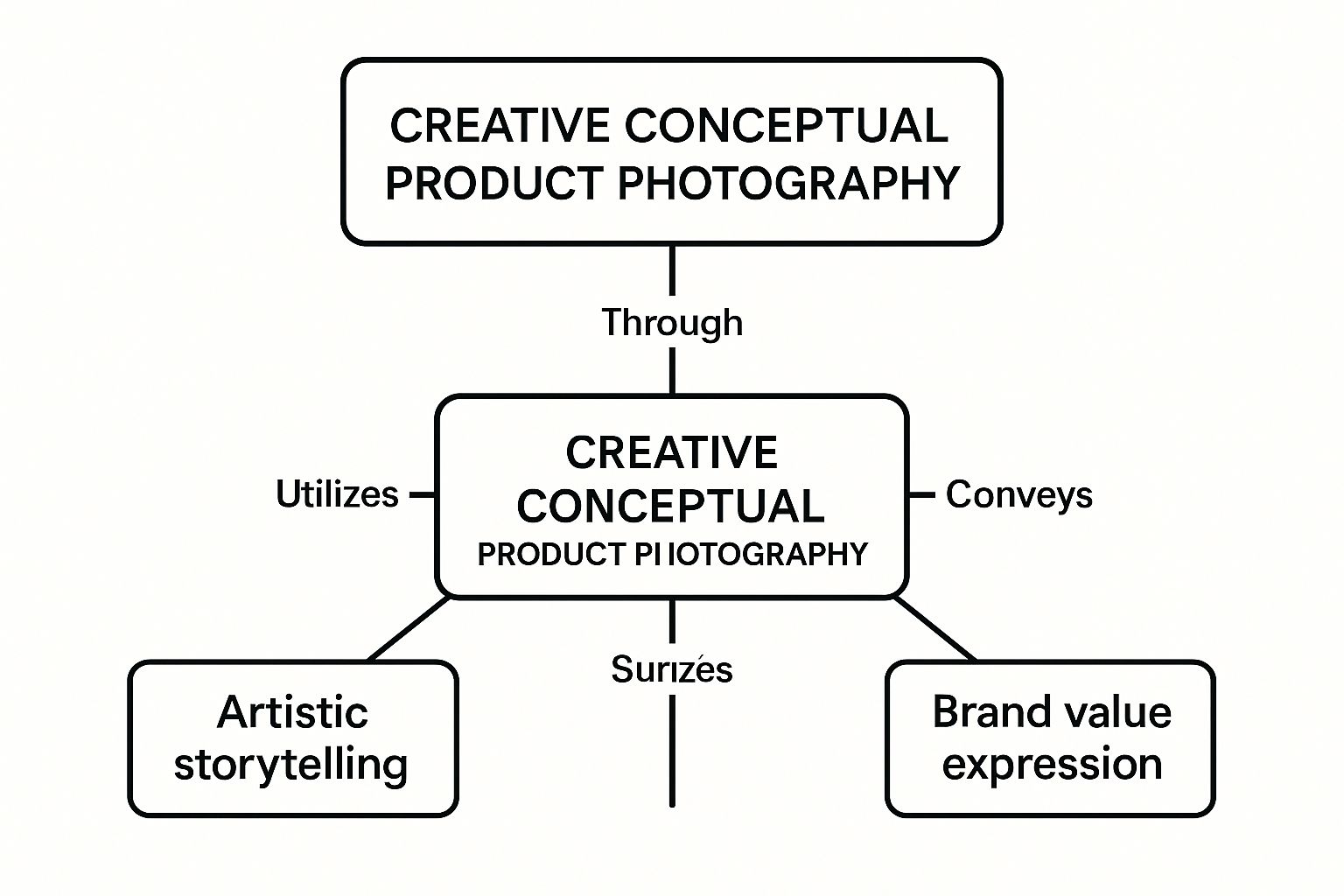
This visualization shows how creative photography blends artistic storytelling and surreal visual elements to effectively express core brand values.
How to Replicate This Style
Developing a strong concept is more important than technical perfection here, but both are required for a successful image.
- Start with a Core Idea: What is the one thing you want your audience to feel or think? Brainstorm concepts that align with your brand's mission and the product's key benefit.
- Storyboard Your Vision: Plan your shot in detail. Sketch out the composition, lighting, props, and any surreal or manipulated elements you intend to include.
- Master Creative Lighting: Use light and shadow to create mood and drama. Colored gels, hard light for sharp shadows, and spotlights can all be used to build a specific atmosphere.
- Leverage Post-Processing: Adobe Photoshop is essential for this style. Use it to composite images, manipulate colors, add textures, or create surreal effects that would be impossible to capture in-camera. The goal is a polished, intentional final image that tells your intended story.
7 Key Product Photography Styles Compared
| Photography Style | Implementation Complexity 🔄 | Resource Requirements ⚡ | Expected Outcomes 📊 | Ideal Use Cases 💡 | Key Advantages ⭐ |
| White Background Product Photography | Low - straightforward lighting and setup | Low - basic lighting and equipment | Clean, professional, and consistent product images | E-commerce platforms and catalogs | Cost-effective, easy consistency, quick editing |
| Lifestyle Product Photography | High - complex styling and natural setups | High - location, props, talent needed | Emotional engagement and brand storytelling | Social media, brand marketing, ads | Builds brand personality, shows product context |
| Flat Lay Product Photography | Medium - overhead setup and styling | Medium - camera mounts and styling skills | Visually appealing multi-product layouts | Social media, product collections, subscription boxes | Cost-effective, visually engaging, social media friendly |
| Ghost Mannequin Photography | High - requires precise shooting and editing | Medium-High - mannequins and post-production | 3D garment visualization, clean professional look | Apparel catalogs, e-commerce fashion | Shows fit well, scalable, model-free presentation |
| Macro Product Photography | Very High - specialized techniques | High - macro lenses and lighting gear | Detailed, artistic close-ups highlighting craftsmanship | Luxury goods, jewelry, technical product details | Showcases fine details, builds premium perception |
| 360-Degree Product Photography | Very High - complex multi-angle capture | Very High - turntables, software, cameras | Interactive, immersive product views | Automotive, furniture, electronics e-commerce | Reduces returns, boosts confidence, competitive edge |
| Creative Conceptual Product Photography | Very High - artistic and conceptual planning | High - creative team and production costs | Memorable, shareable brand images | Brand campaigns, social media, print ads | Differentiates brand, encourages social sharing |
Transforming Inspiration into High-Converting Imagery
Throughout this curated gallery, we've journeyed through a diverse landscape of powerful product photography examples. From the crisp, clean precision of white background shots to the immersive storytelling of lifestyle scenes, each image serves a distinct strategic purpose. The examples showcased are more than just pretty pictures; they are carefully engineered sales tools, designed to stop the scroll, build trust, and drive conversions.
We've seen how flat lays can elegantly display product collections, how ghost mannequin photography offers a realistic fit without distraction, and how macro shots highlight the premium details that justify a higher price point. The dynamic nature of 360-degree views and the brand-defining power of creative conceptual images demonstrate that the possibilities are limited only by your imagination and strategy. The common thread connecting all these successful examples is a deep understanding of the target audience and the product's core value proposition.
Your Action Plan for Better Product Photos
Moving from inspiration to implementation is the most critical step. To turn these insights into tangible results for your own brand, focus on these core pillars:
- Define Your Goal: Before you pick up a camera, ask what you want each image to achieve. Is it to show scale, highlight a specific feature, evoke an emotion, or simply provide a clear, unambiguous view of the product? Your objective will dictate your entire photographic approach.
- Master the Fundamentals: Solid lighting, stable composition, and sharp focus are non-negotiable. Whether you're using a professional DSLR or a smartphone, these basics are the foundation upon which all creative techniques are built. Revisit the techniques in the examples above, from using diffusers for soft light to employing the rule of thirds for balanced compositions.
- Tell a Cohesive Brand Story: Your product photography is a direct extension of your brand identity. Ensure your images, from the color palette and props to the overall mood, align with your brand's voice and values. Consistency across all your product visuals builds brand recognition and customer loyalty.
- Test, Analyze, and Iterate: Don't be afraid to experiment. Try different backgrounds, lighting setups, and compositions. Use A/B testing on your product pages or social media posts to see which images resonate most with your audience and lead to higher engagement or sales.
Ultimately, investing in high-quality product photography is an investment in your business's success. These images are your digital storefront, your 24/7 salesperson, and your primary tool for making a memorable first impression. After exploring these product photography examples, remember that the final presentation online is just as important as the capture. It's crucial to optimize website images to ensure your stunning visuals load quickly and provide an excellent user experience for every visitor. By combining compelling photography with technical performance, you create a seamless and persuasive path to purchase.
Feeling inspired by these product photography examples but need a faster, more consistent way to create high-quality images? ProdShot uses AI to transform your simple product photos into stunning, professional-grade visuals in seconds. Skip the expensive photoshoots and complex editing by trying ProdShot today to generate endless on-brand imagery that sells.
Subscribe to my newsletter
Read articles from ProdShot Creator directly inside your inbox. Subscribe to the newsletter, and don't miss out.
Written by
